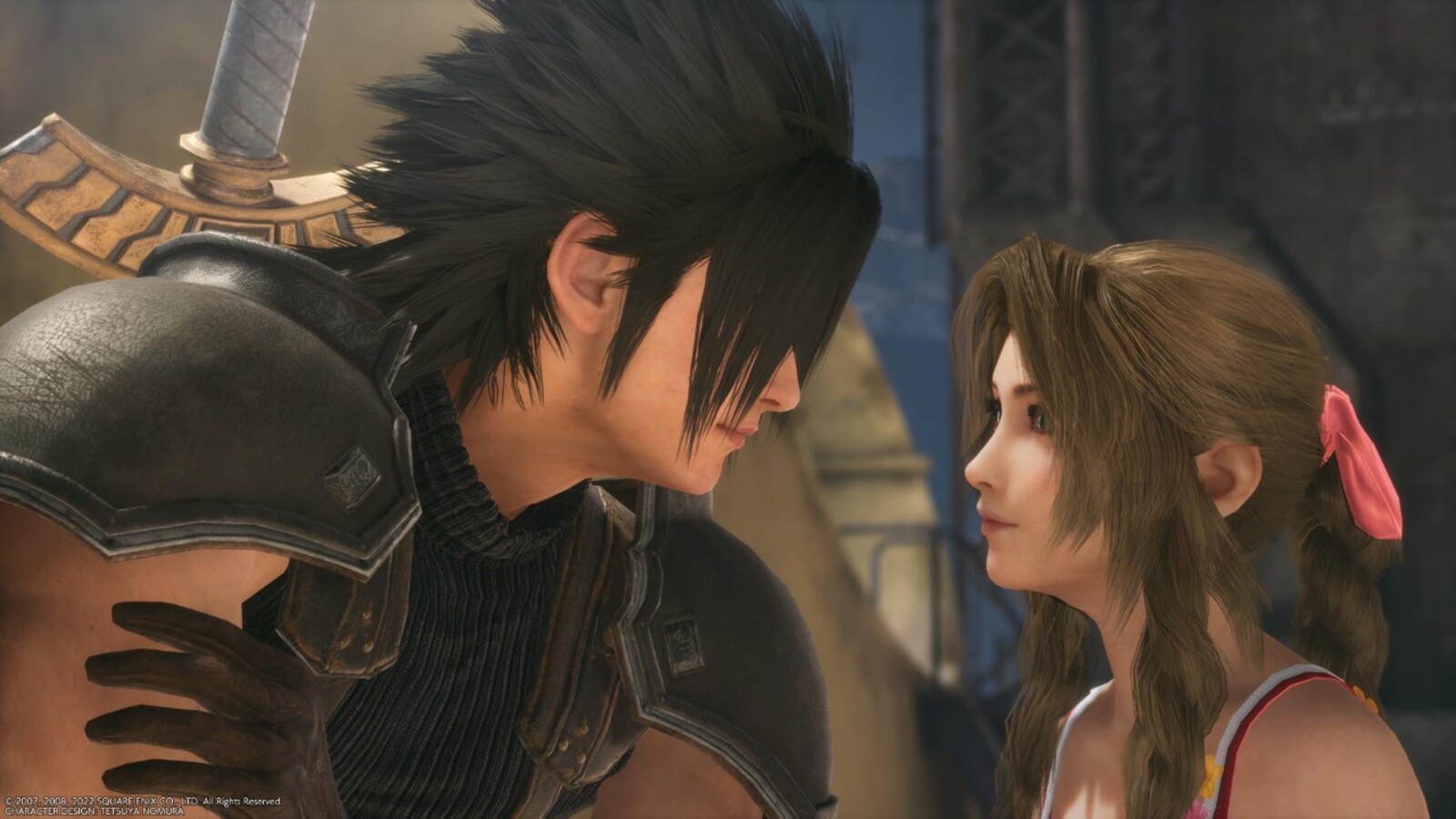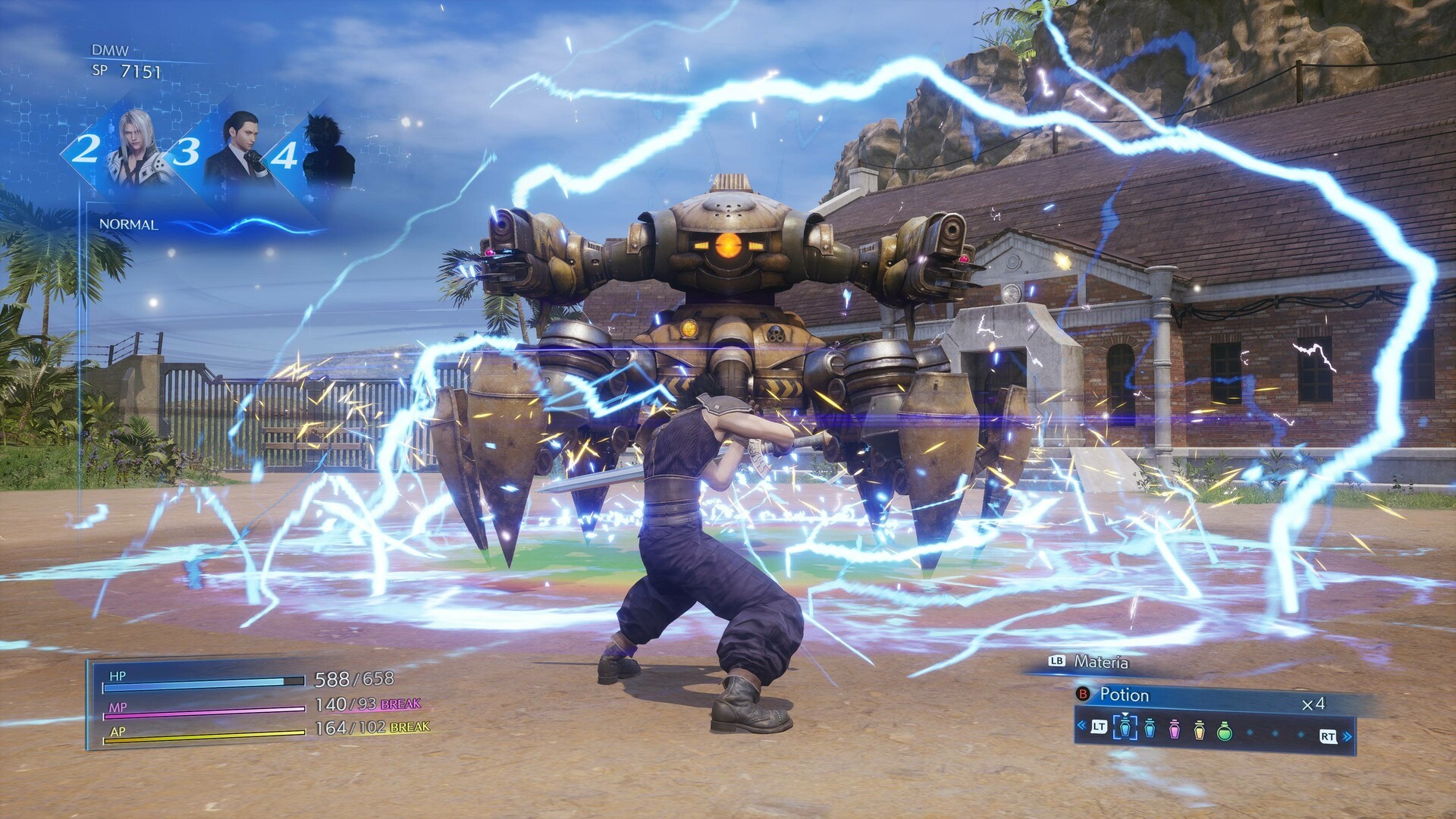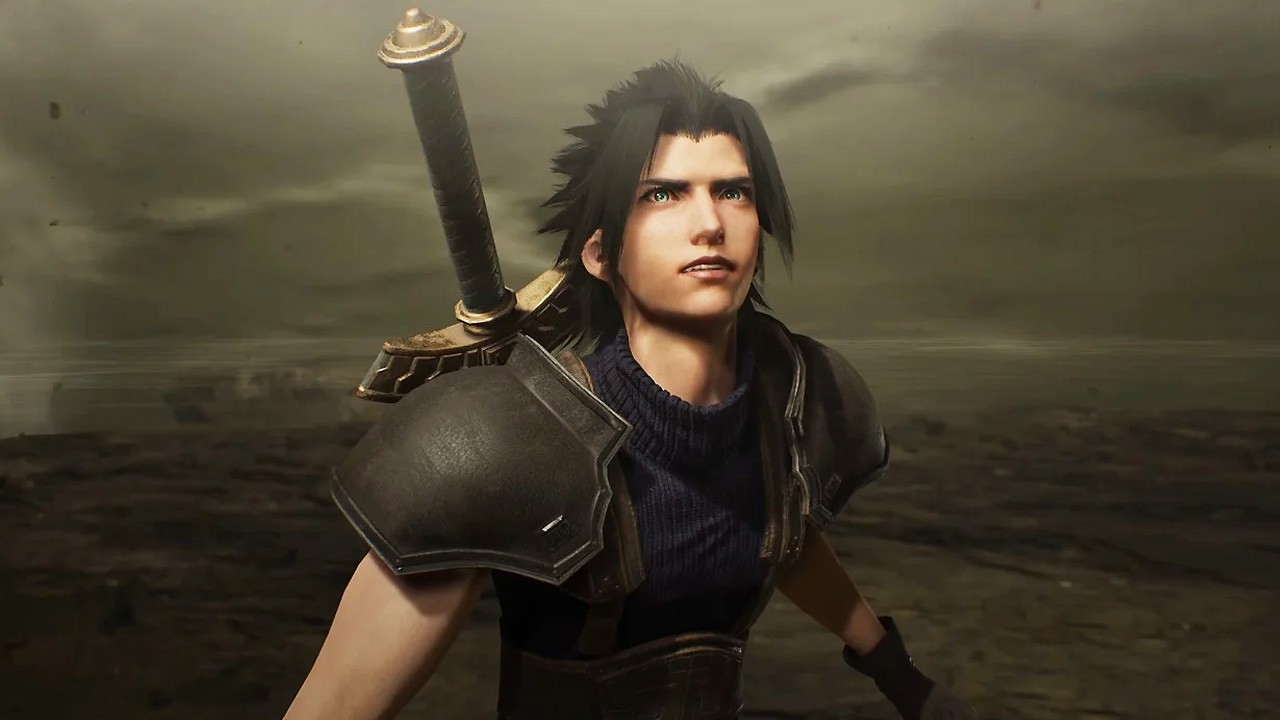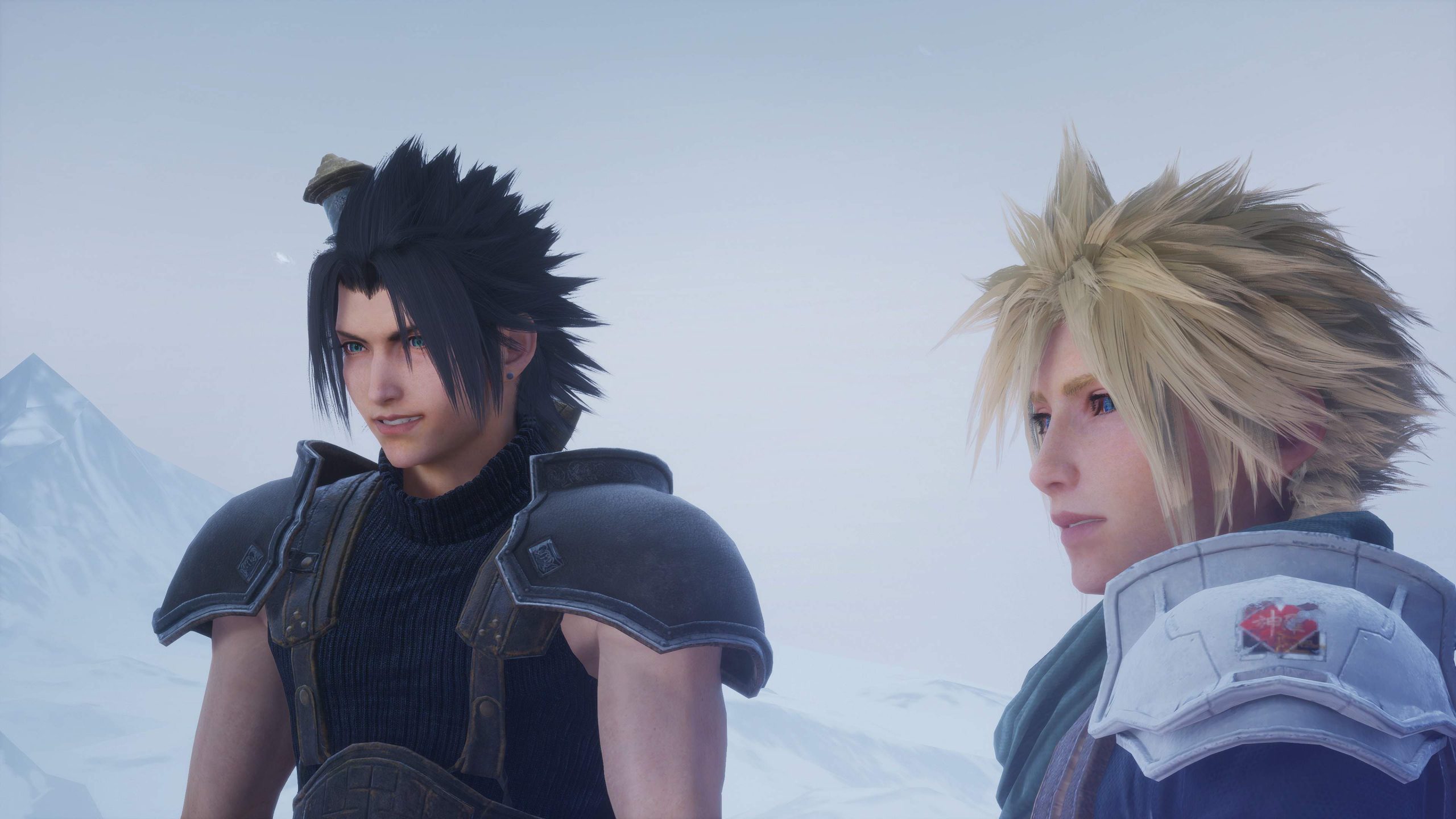After 15 years, Crisis Core is back with a remastered version of the game, Crisis Core – Final Fantasy VII – Reunion. The remaster tells the same incredible tale of Zack Fair, but overhauls the graphics and improved gameplay. This is our official review of Crisis Core – Final Fantasy VII – Reunion.

A Powerful Story Every Final Fantasy Fan Should Experience
Originally released in 2007 for the PSP, Crisis Core told the story of Zack Fair; a vital character in the overall Final Fantasy VII story. This game has long been considered as one of the most impactful, heartfelt stories in the Final Fantasy VII timeline. With some feeling it was even more poignant than the mainline game.
However, because it was released on the PSP 15 years ago, it’s not a game every Final Fantasy fan has played. Thankfully, Square Enix has remastered Crisis Core – Final Fantasy VII for modern consoles to reach new players. With the success of Final Fantasy VII Remake and its sequel on the horizon, the release of Crisis Core – Final Fantasy VII – Reunion feels even more crucial.
If you’re unfamiliar with the game, Crisis Core – Final Fantasy VII – Reunion is a prequel to the main Final Fantasy VII game. It follows SOLDIER 2nd Class Zack Fair, as he strives to fulfill his dream of becoming a hero. On his journey to become a hero, Zack takes part in the war against Wutai, uncovers an unexpected mystery, interacts with Sephiroth (plus several other beloved FFVII characters), and sheds more light on that iconic Nibelheim scene every FFVII fan knows about. Furthermore, his story adds profound depth to the main FFVII protagonist, Cloud Strife.
When I first played Crisis Core, I didn’t expect it to be as deep as it is. I mean, when you first meet Zack, he’s an immature goofball. He is naive of the world and isn’t concerned with the complexities of it. Instead he’s all about proving himself. Thus, it makes the tone in the early parts of the game feel very light-hearted, despite serious events going on around him.
What transpires, though, is so traumatic and unexpected it forces Zack to mature and face his naivety. Seeing his growth is one of the best parts of Crisis Core, as it completely shifts the tone from light-hearted fun to serious and, at times, tragic. It’s pretty amazing it can do all that with a story roughly 12 hours long.
Another element that makes Crisis Core so wonderful is how it shows sides of beloved characters we hadn’t seen before. In Zack’s journey, he interacts with Sephiroth, Cloud, the Turks, Tifa, and of course Aerith. In the main Final Fantasy game, Sephiroth is a man obsessed with cleansing the world, and Cloud is a brooding mute. The Turks aren’t given a ton of air time to get to know them outside of Reno, and Aerith is a fiery, yet funny extrovert.
Crisis Core gives players the chance to see who they were before Final Fantasy VII. Sephiroth is cool, smart, and seems like a good leader. Cloud is warmer and full of wonder, the Turks have a softer side to them, and Aerith kind of seems a bit spoiled but in a delightful way. Seeing these different sides to characters we’ve grown up with is one of many reasons why Final Fantasy VII fans need to experience this game regardless if they have or haven’t previously.
All that said, while the main story is excellent, there are some “filler” storylines used to expand the game to pad out the play time. The filler storylines in particular mostly take place in the slums and aren’t as fun or meaningful as Square Enix was hoping for. Take the Aerith/Zack (Aerick? Zarith?) storyline, for example, which often features a kid named Bruno. He’s used as a plot device to build Aerith and Zack’s relationship, yet, every mission with him dragged on far too long and took me out of the story.
However, that’s a small part in an otherwise incredible story. With Final Fantasy VII Rebirth coming within the next year or two, Crisis Core – Final Fantasy VII – Reunion is a story that all Final Fantasy VII fans need to play to get some much-needed depth and understanding of how the past has a direct impact on the present story.

Uniquely Fun Combat Mechanics; Repetitive, Easy-to-Break Level Design
Every time a new Final Fantasy game releases, Square Enix puts an emphasis on changing up the combat mechanics by adding in new elements. The original Final Fantasy VII was strictly turn-based while Final Fantasy VII Remake was more real-time. Crisis Core – Final Fantasy VII – Reunion is similar to the Remake’s combat style, but with an added element of the DMW (Digital Mind Wave).
When I first played Crisis Core, I didn’t know how to feel about the DMW system. It’s basically a slot machine that will spin throughout combat, randomly stopping on numbers and different characters. These characters are people that Zack meets and interacts with. At times, his feelings towards a particular character can be heightened leading to the DMW system stopping on them more often.
The DMW system has some impressive benefits. It can randomly make Magic or Abilities cost no points, make you invulnerable, activate summons, and even perform limit breaks unique to particular characters. For example, if all three DMW slots land on Aerith, you can perform Healing Wave and the accompanying number will dictate how powerful it is.
While lottery systems in combat have a potential to be annoying, I actually grew to love the DMW system. It made each battle more exciting and unpredictable. Plus, if you got the right slots, you could wind up going into God Mode and pulverizing foes. No Cost MP was my favorite, as I could just spam Blizzaga over and over, causing 9999 damage and obliterating everyone.
Speaking of spamming Blizzaga…Crisis Core has unlockable missions that are intended to expand the story in places where the main story can’t. However, it’s more of a tool for getting more powerful and collecting critical resources. These missions are pretty formulaic, though and not all that hard.
Each mission will take you to one of like four maps, where you’ll have a select number of optional chests to find and then fight a mini-boss. I enjoyed these missions merely because they gave me the opportunity to get stronger. However, from a challenging standpoint: it wasn’t. Even five-star enemies were simple after a certain point. Plus, the maps and missions themselves were repetitive.
Plus, if I wanted to avoid enemies, all I had to do was run along the sides of the map. Even in the main storyline, I could just run along the walls and edges of the map to avoid conflicts and save my strength for main bosses. This doesn’t seem like a function Square Enix meant to be possible, but it’s pretty easy to break the random enemy system. Just don’t walk in the middle of the map.
All that doesn’t take away from the combat system, though. The system itself is unique and a lot of fun. It’s just clear not a lot was put into the level design like they were in the main line Final Fantasy VII games.

Crisis Core Has Never Looked Better
Stop me if you’ve heard this one before: A Final Fantasy game has great graphics. Of course, that’s one of the trademarks of Final Fantasy games. They tend to push the boundaries of the system they’re on with every new game. 15 years ago, Crisis Core did that on the PSP, impressing with some amazing graphics for its time.
As this is a remastered version of the game for modern consoles, Crisis Core – Final Fantasy VII – Reunion enhances what Crisis Core accomplished in 2007. It doesn’t exactly push new boundaries, but that’s not really the goal of the 2022 remaster. Even so, the graphics and art still feel modern and clean.
That’s not exclusive to cinematics, either. The art within gameplay also looks fresh and modern. Meanwhile, the cinematics look fantastic. The only part where the graphics do appear to be dated is in dialogue scenarios, although, that’s to be expected in a remaster. It can’t all be perfect. What they were able to accomplish, however, is still impressive.

Should You Play It?
If you are a Final Fantasy fan, someone who played Final Fantasy VII Remake, or simply want a gateway game into the franchise, then you have to play Crisis Core – Final Fantasy VII – Reunion.
Without a doubt, it’s one of the most important games in the entire Final Fantasy VII story. It’s necessary for players to play this game to understand the past in preparation for Final Fantasy VII Rebirth. Even if Final Fantasy VII Rebirth wasn’t a little over a year away, Square Enix was very smart to remaster Crisis Core. More people need to play it and experience its story. It provides depth for characters, but more importantly it tells the story of Zack Fair, the quiet hero of Final Fantasy VII.
The game may not always feel like a $70 AAA game of recent years, but that doesn’t take away from the overall impact of the story. Plus, it’s only about 12-15 hours, which anyone can make quick work of if they need a breather from 40 hour open-world games.
Crisis Core – Final Fantasy VII – Reunion gets our seal of approval as a must-play game for anyone remotely interested in Final Fantasy VII.

